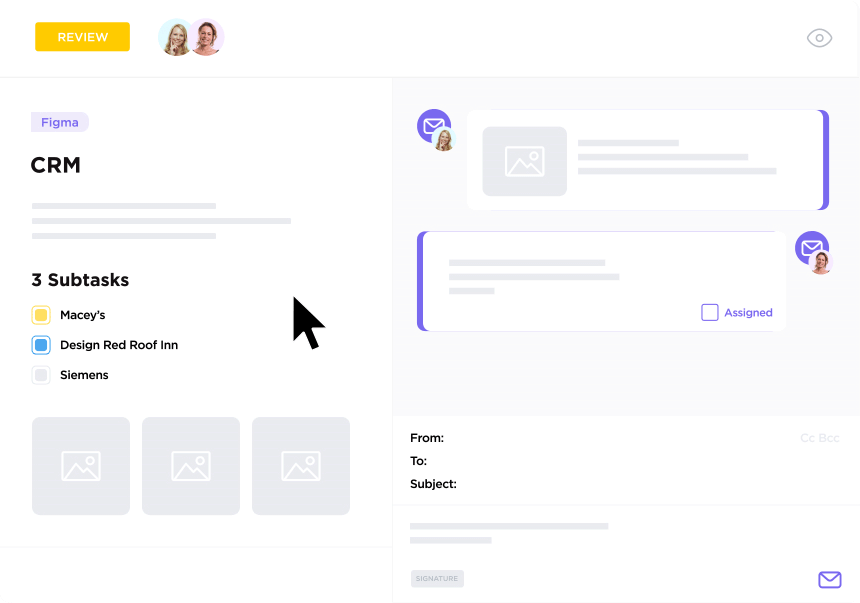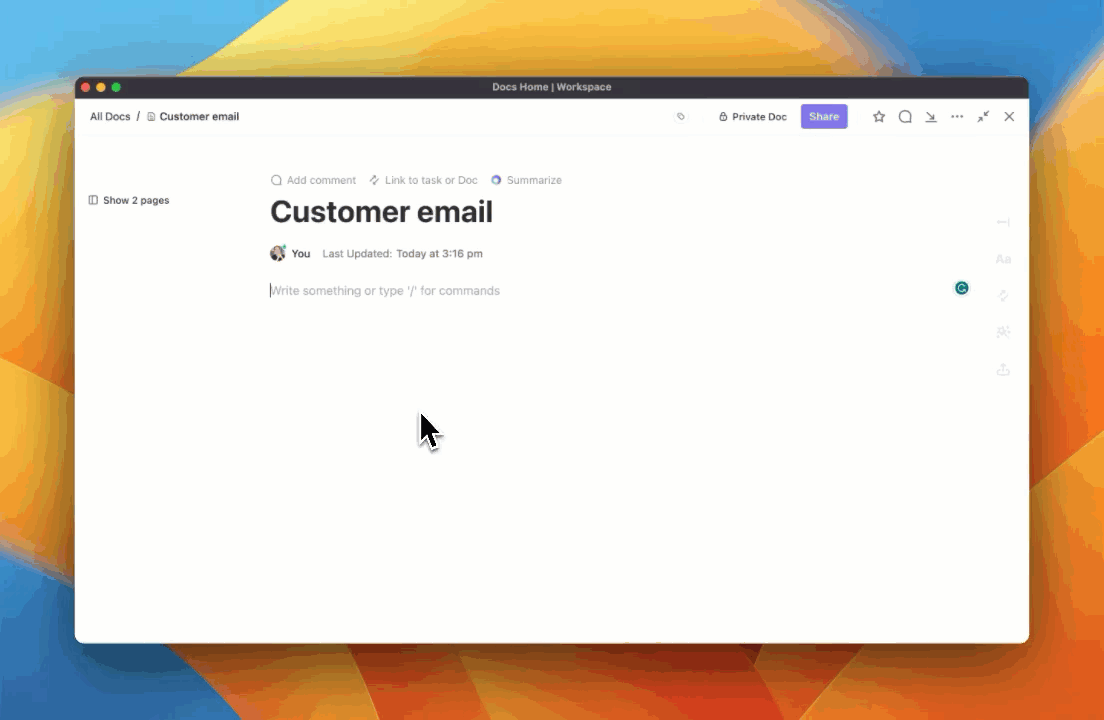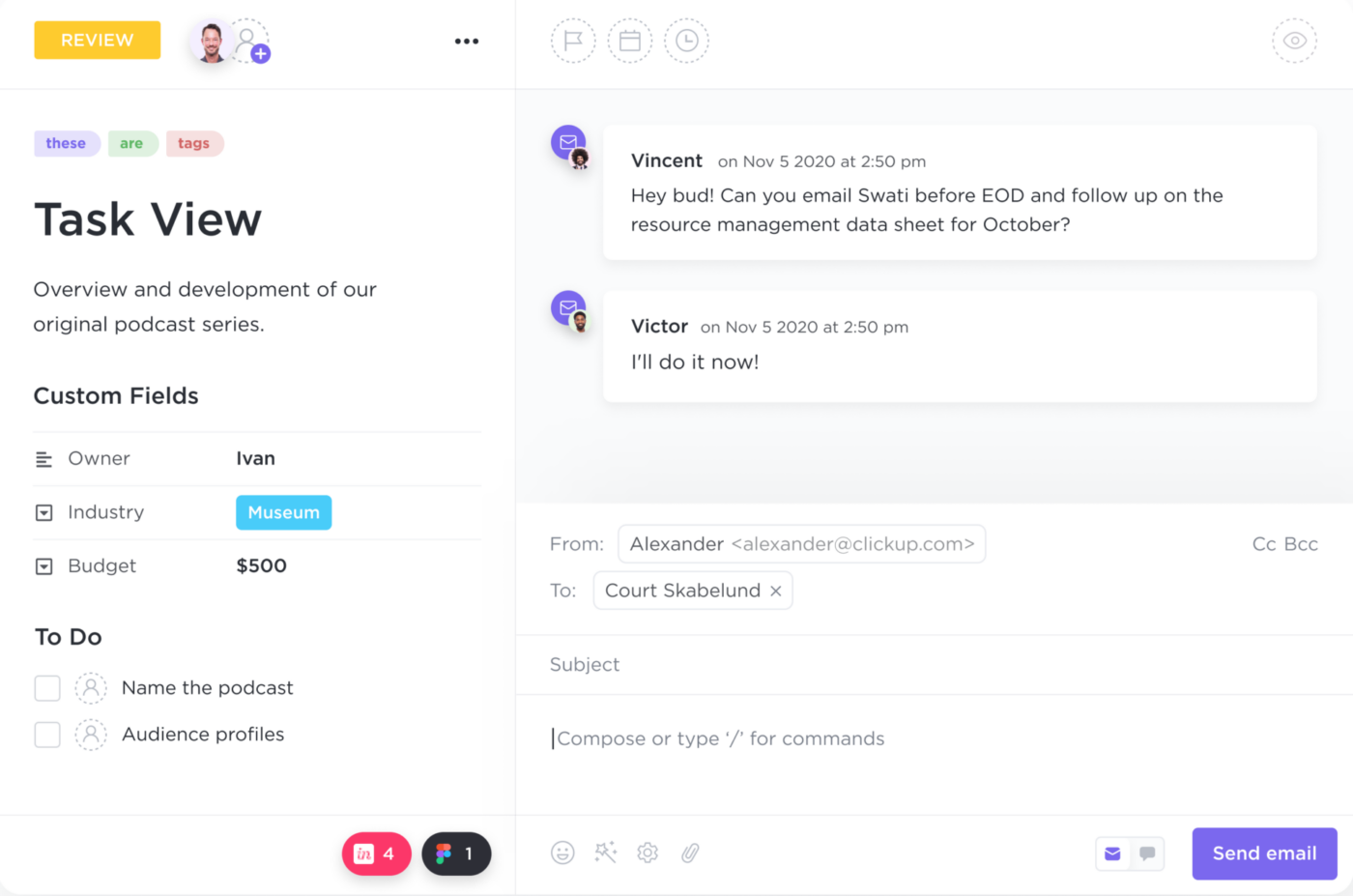تخيل روتينك اليومي في العمل. ما هو أول شيء تفعله عندما تبدأ يوم عملك؟ على الأرجح، يبدأ يومك بتفقد رسائل البريد الإلكتروني. في الواقع، قد يكون ذلك سمة متكررة، نظرًا لأن المهنيين يتفقدون رسائل البريد الإلكتروني الخاصة بهم في جميع أنحاء 15 مرة يومياً !
هل تنبعث إشعارات بريدك الإلكتروني، ولديك الكثير من رسائل البريد الإلكتروني في صندوق الوارد الخاص بك ولا تعرف من أين تبدأ؟ أنت في المكان الصحيح للحصول على نصائح لإدارة البريد الإلكتروني.
قد يسوء الوضع لدرجة أنك قد تعاني من قلق البريد الإلكتروني (لا، لم نختلق ذلك!). إنها حالة مشروعة تتسم بالشعور بالخوف والقلق الشديد الذي يؤثر على الإنتاجية ويترك أثراً على صحتك النفسية.
لحسن الحظ، لدينا أفضل 10 استراتيجيات لإدارة البريد الإلكتروني لمنعك من الدخول في مثل هذه الحالة.
ما الذي يسبب ازدحام صندوق البريد الإلكتروني؟
المشكلة واضحة جداً - صندوق الوارد الخاص بك مليء برسائل البريد الإلكتروني. قبل اقتراح الحل، نحتاج إلى النظر إلى المشكلة الأساسية. فيما يلي بعض الأسباب الكامنة وراء صندوق البريد الإلكتروني المزدحم:
- كميات كبيرة من رسائل البريد الإلكتروني: في عام 2022، حوالي 333 مليار بريد إلكتروني تم إرسالها أو استلامها يومياً. وسيتضخم هذا الرقم إلى 392.5 مليار بحلول عام 2026! تسلط هذه الإحصاءات الضوء على الحجم الهائل لرسائل البريد الإلكتروني المرسلة والمستلمة يوميًا، والتي تتزايد فقط ولا بد أن تشغل حيزًا في صندوق الوارد لأي شخص بسرعة
- التسويف: في المتوسط، صندوق بريدك الوارد عبارة عن مقبرة من 200 بريد إلكتروني-مع 121 رسالة بريد إلكتروني جديدة تُضاف يوميًا. ومع ذلك، لا يتلقى سوى جزء بسيط منها ردًا، مما يؤدي إلى تأثير تراكمي. إن كومة الرسائل الإلكترونية الناتجة عن ذلك كافية لإحداث شلل في اتخاذ القرارات، مما يؤدي إلى المماطلة. بالإضافة إلى ذلك، فإن العثور على اللغة والنبرة الصحيحة أثناء صياغة المراسلات المكتوبة هو عقبة أخرى تعترض طريق إنجاز رسائل البريد الإلكتروني بسرعة
- عدم التنظيم: يستهلك تنظيم البريد الإلكتروني اليدوي ما يصل إلى 14 دقيقة في اليوم في المتوسط. وعلى الرغم من أن ذلك قد لا يبدو كثيرًا، إلا أن عدم وجوده يزيد من تفاقم فوضى البريد الوارد. التجميع الشامل لرسائل البريد الإلكتروني يجعل تحديد الأولويات والرد على رسائل البريد الإلكتروني المهمة أكثر صعوبة. في الوقت نفسه، تحتاج إلى معرفة موقع رسائل البريد الإلكتروني لمراجعتها لاحقًا وأيها لا يتطلب أي إجراء
- الاشتراكات في النشرات الإخبارية: ستؤدي استراتيجية التسويق عبر البريد الإلكتروني الناجحة إلى تحويل القراء إلى مشتركين. ومع ذلك، يأتي وقت تفقد فيه رسائل البريد الإلكتروني هذه قيمتها. أو، حتى لو كانت تحتوي على شيء مثير للاهتمام، فسوف تُدفن في الفوضى وتصبح جزءًا من الحطام والركام في صندوق الوارد الخاص بك. وعلى هذا النحو، فإن عدم إلغاء الاشتراك في مثل هذه الرسائل الإخبارية سيجعل من الصعب إدارة صندوق الوارد الخاص بك
- إدارة المهام من خلال رسائل البريد الإلكتروني: الكثير منا مذنبون باستخدام صندوق الوارد الخاص بنا كمديرين للمهام. فالرسائل غير المقروءة تنتمي إلى قائمة المهام، بينما الرسائل التي لم تقرأها هي التي تعاملت معها. مثل هذا النظام من إدارة مهام البريد الإلكتروني قد يخدم الغرض منه بشكل مؤقت وعلى المدى القصير. ومع ذلك، فإن الاستمرار في ذلك سيؤدي بسرعة إلى وجود عدد هائل من الرسائل غير المقروءة في صندوق الوارد الخاص بك، اعتمادًا على طول أو تعقيد المهام المرتبطة بها
10 استراتيجيات لإدارة البريد الإلكتروني لتنظيم صندوق الوارد الخاص بك
سيصبح التعامل مع رسائل البريد الإلكتروني أسهل مع أدوات إنتاجية البريد الإلكتروني واستراتيجيات إدارة البريد الإلكتروني التكميلية. إليك 10 طرق لتحقيق أقصى استفادة منها:
1. استخدم أداة إدارة البريد الإلكتروني

إدارة رسائل البريد الإلكتروني والعمل في مكان واحد-إرسال واستقبال رسائل البريد الإلكتروني من أي مكان في ClickUp، وإنشاء مهام من رسائل البريد الإلكتروني، وإعداد الأتمتة، وإرفاق رسائل البريد الإلكتروني بأي مهمة، والمزيد
إهدار صندوق الوارد الكامل 27 دقيقة يوميًا، وحتى هذا تقدير طموح. يجب عليك مراجعة رسائل البريد الإلكتروني يدويًا (أو على الأقل سطور موضوعها)، وتحديد ما إذا كانت مفيدة، وتنظيم رسائل البريد الإلكتروني حسب الأولوية والمرسل وما إلى ذلك.
عليك أن تكون شديد التركيز (وبشرياً خارقاً) لإنجاز كل ذلك في الدقائق ال 27 المذكورة!
من ناحية أخرى، فإن الفعالية برنامج إدارة البريد الإلكتروني مثل تلك التي تقدمها ClickUp، ستقوم بكل ذلك من أجلك. تُحدث أدوات إدارة البريد الإلكتروني ثورة في تنظيم صندوق الوارد. استخدمها لفرز رسائل البريد الإلكتروني حسب الأولوية، وتأجيل الإشعارات، وتصنيف رسائل البريد الإلكتروني بذكاء لإدارة التدفق الوارد بخبرة.
بالإضافة إلى ذلك، عند استخدام ClickUp لإدارة البريد الإلكتروني، لن تضطر إلى الانتقال إلى واجهة غير مألوفة. ستحصل على نفس السهولة والراحة التي يوفرها لك التصميم القياسي الذي يقدمه مزودو خدمات البريد الإلكتروني المعروفون.
لذا، استفد من أتمتة البريد الإلكتروني هذه للتركيز على الأشياء التي تستحق اهتمامك حقًا.
2. إنشاء روتين للبريد الإلكتروني
في المتوسط، يتفقد الأفراد بريدهم الإلكتروني كل 37 دقيقة أو 15 مرة في اليوم . يؤدي القيام بذلك إلى مقاطعة الإنتاجية وإهدار ما يقرب من 21 دقيقة في اليوم الواحد أكثر مما كان سيقضيه في التحقق من البريد الإلكتروني كل ساعة.
حتى عمليات التحقق كل ساعة تُضعف الإنتاجية إلى حد ما، حيث أنك ستتعامل مع المهمة (أ) بينما تقلق بشأن المهمة (ب) التي تلقيتها للتو! يوصي الخبراء بتفقد بريدك الإلكتروني ثلاث مرات في اليوم على الأكثر.
أولاً، قم بإعداد جدولك عندما تبدأ يومك في الصباح. ثانياً، في فترة ما بعد الظهر، بعد استراحة الغداء، قم بمعالجة أي أمور ملحة ومتابعتها. وأخيراً، قبل نهاية يوم العمل - قبل نهاية يوم العمل - قم بالرد على اتصالات اليوم ووضع جدول أعمال لليوم التالي.
إن اتباع هذا الروتين يقضي على التشتت ويحافظ على الإنتاجية ويوفر راحة البال.
3. التنظيم باستخدام الملصقات والمجلدات والفئات
يقدم معظم موفري خدمات البريد الإلكتروني علامات تبويب قياسية لمساعدة المستخدمين على تنظيم صندوق الوارد الخاص بهم. على سبيل المثال، تنتهي رسائل البريد الإلكتروني العادية في علامة التبويب الأساسية أو البريد الوارد الرئيسي بشكل افتراضي، بينما تتدفق رسائل البريد الإلكتروني التسويقية إلى علامة تبويب العروض الترويجية، وتحتوي علامة التبويب الاجتماعية على الإشعارات من وسائل التواصل الاجتماعي في Gmail. أما البقية فتذهب إلى مجلد الرسائل غير المرغوب فيها.
بالإضافة إلى ذلك، يحصل المستخدمون على الأدوات التنظيمية مثل التصنيفات والمجلدات والفئات لتبسيطها بشكل أكبر. اتبع نهجًا وظيفيًا أو قائمًا على الأدوار أثناء إنشاء المجلدات لفرز بريدك الإلكتروني والتنقل فيه بسهولة. على سبيل المثال، لنفترض أنك مدير مشروع يقوم بإنشاء موقع إلكتروني.
بالنسبة للبريد الوارد لـ إدارة مشروع البريد الإلكتروني -إنشاء مجلدات منفصلة مخصصة للمطورين وفرق التصميم والاختبار والنشر والعملاء. ثم، بناءً على أولوية المشروع ومرحلة التطوير، تحقق من المجلد المناسب الذي يهمك أولاً.
4. تصنيف رسائل البريد الإلكتروني باستخدام عوامل التصفية المستندة إلى قواعد
بما أننا نتحدث عن تنظيم البريد الإلكتروني وتصنيفه، دعنا نناقش المرشحات المستندة إلى القواعد.
الفلاتر المستندة إلى القواعد هي اختراق سريع لأتمتة البريد الإلكتروني لفرز الرسائل. تقوم بتقييم رسائل البريد الإلكتروني الواردة بناءً على معايير محددة مسبقًا مثل عنوان البريد الإلكتروني للمرسل وأسطر الموضوع وكلمات رئيسية محددة.
ثم، استنادًا إلى هذه الشروط، تقوم بتشغيل الإجراءات التلقائية، مثل تطبيق التسميات، والانتقال إلى المجلدات، وتمييز النص، وحتى حذف رسائل البريد الإلكتروني.
على سبيل المثال، يمكنك إعداد فلتر يستند إلى قاعدة لأسماء العملاء المهمين. سيتم تصنيف رسائل البريد الإلكتروني المتعلقة بهذا الموضوع، الداخلية والخارجية على حد سواء، بشكل فعال ونقلها إلى مجلد مخصص لسهولة الوصول إليها.
من ناحية أخرى، يمكنك تفريغ رسائل البريد الإلكتروني الترويجية في مجلد آخر باستخدام فلتر آخر قائم على القواعد. وبهذه الطريقة، ستقلل من الفوضى المرئية في صندوق الوارد الأساسي مع الحصول على رؤية كاملة لرسائل البريد الإلكتروني المهمة.
بالإضافة إلى ذلك، نظرًا لأن المحترفين يضيعون حوالي 11 دقيقة يوميًا في فرز رسائل البريد الإلكتروني يدويًا، ستوفر أيضًا الوقت والجهد.
5. الجرأة على الحذف (وإلغاء الاشتراك)
يعد حذف رسائل البريد الإلكتروني غير الضرورية استراتيجية استباقية لإدارة البريد الإلكتروني لتحقيق صندوق بريد إلكتروني منظم ومنظم ومبسط ومنظم.
إن إزالة جميع الرسائل غير المرغوب فيها وغير ذات الصلة والتي عفا عليها الزمن لا تمنع فقط اكتناز الرسائل، بل هي أيضًا مريحة للغاية. فهي تمنحك التحكم في تدفق رسائل البريد الإلكتروني وتساعدك على الشعور بالارتباك.
كما أن الوضوح المرئي يوفر عليك العبء المعرفي والإحباط الناتج عن غربلة رسائل البريد الإلكتروني غير المهمة وجعل الرسائل قابلة للبحث.
تنطبق الفلسفة نفسها على إلغاء الاشتراك من الرسائل الإخبارية وحملات التسويق عبر البريد الإلكتروني. استخدم رابط إلغاء الاشتراك إذا بقيت رسالة بريد إلكتروني ترويجية أو رسالة إخبارية غير مقروءة في صندوق الوارد لأكثر من أسبوعين.
لا تعرف ما إذا كان البريد الإلكتروني يستحق الاحتفاظ به أو يستحق الحذف؟ اتبع نموذج أوهيو (فقط قم بتسليمها مرة واحدة) لاتخاذ القرار. يعتمد هذا الاختبار ذو اللمسة الواحدة على الانطباعات الأولى لاتخاذ قرارات بديهية بشأن ما إذا كان البريد الإلكتروني يقدم أي قيمة. على هذا النحو، أنت في غنى عن معاناة المداولات المستمرة حول ما إذا كان البريد الإلكتروني "يستحق ذلك"
بالإضافة إلى ذلك، يمكن وضع البريد الإلكتروني في سلة المهملات لمدة 30 يوماً كشبكة أمان. يمكنك استعادتها إذا لزم الأمر - وإذا تم حذفها تلقائيًا، فلن تحتاج إليها على أي حال! يمكنك أيضًا استخدام مجلد الأرشيف لوضع جميع رسائل البريد الإلكتروني التي قرأتها بالفعل.
6. إرسال القليل، واستقبال القليل
مع زيادة انتشار رسائل البريد الإلكتروني في كل مكان، أصبح من الأسهل بكثير المراسلة من خلالها. ومع ذلك، إذا كنت تميل إلى إرسال عدد كبير جدًا من رسائل البريد الإلكتروني، خاصةً للأمور البسيطة، فاستعد لتلقي نفس المعاملة. كما يؤدي البريد الإلكتروني أيضًا إلى خيوط طويلة ومعقدة من التبادلات الكتابية، والتي تخرج عن السيطرة بسهولة.
وعلى العكس من ذلك، فإن تقليل حجم رسائل البريد الإلكتروني الصادرة يقلل من سيل الردود والاستجابات الواردة. سوف تقدم خدمة لصندوق الوارد الخاص بك وتساهم في توفير مساحة عمل رقمية أكثر تركيزًا وتنظيمًا تعتمد على القيمة الأمامية.
التحويل إلى بدائل البريد الإلكتروني مثل المراسلة الفورية أو أدوات إدارة المشاريع أو حتى المكالمات الهاتفية ستعطي الأولوية للتواصل الموجز والواضح. لن تكون مضطرًا بعد الآن إلى صياغة رسائل بريد إلكتروني مطولة مع التحية والخطابات والدخول مباشرةً في صلب التحديث والمناقشة.
مع ثقافة التواصل الإيجابية والمقصودة والهادفة هذه، ستوفر الوقت والجهد وتنجز المزيد من المهام في وقت أقل.
7. إعداد الردود المعلبة

خيارات قالب البريد الإلكتروني داخل ClickUp
هل تكتب وترسل في كثير من الأحيان رسائل البريد الإلكتروني نفسها (أو رسائل بريد إلكتروني متشابهة) بشكل متكرر؟ إذا كانت الإجابة بنعم، فقد حان الوقت للتبديل إلى قوالب البريد الإلكتروني والردود المعلبة بدلاً من ذلك.
ليس من الضروري أن تكون كاتباً بارعاً في صياغة الردود المعلبة على الرسائل والاستفسارات الشائعة. ففي النهاية، ليس عليك كتابة رسائل البريد الإلكتروني من الصفر! ما عليك سوى اختيار أداة كتابة البريد الإلكتروني وأطعمها المطالبات الصحيحة، وستحصل على عدة خيارات للردود المعلبة في ثوانٍ!

استخدم ClickUp AI للكتابة بشكل أسرع وصقل نسختك وردودك على البريد الإلكتروني والمزيد
بصرف النظر عن جعل هذه المهمة أسهل وأقل استهلاكا للوقت، تضمن هذه الأدوات اتساق العلامة التجارية وتقليل الأخطاء مع الحفاظ على معدلات استجابة عالية.
أدوات مثل ClickUp AI يُضفي قابلية توسع لا نهائية تقريبًا للشركات حيث يمكنك إنشاء ردود مخصصة بذكاء على كميات كبيرة من الرسائل والاستفسارات المتشابهة.
يوفر ClickUp AI مرونة في صياغة رسائل البريد الإلكتروني لحالات استخدام وتطبيقات محددة، وتسويق المحتوى، وتخطيط الأحداث، وكتابة الاستبيانات، وغير ذلك. استخدمه لجعل رسائل البريد الإلكتروني أكثر وضوحًا وإيجازًا وتنسيقًا جيدًا.
8. اتبع قاعدة الدقيقتين
تسير استراتيجيات إدارة البريد الإلكتروني والإدارة الفعالة للوقت جنبًا إلى جنب. لقد أوضحنا بالفعل كيف أن الإدارة السيئة للبريد الوارد تستنزف الوقت والموارد. وعلى العكس من ذلك، فإن وجود القليل من الوقت يجعل من الصعب التعامل مع رسائل البريد الإلكتروني بكفاءة.
توازن قاعدة الدقيقتين بشكل مثالي بين الوقت والتنظيم للتخفيف من المماطلة. ووفقًا لهذا المبدأ، إذا كنت تحتاج إلى أقل من دقيقتين لإكمال مهمة ما، فقم بالرد عليها فورًا بدلاً من تأجيلها.
في حالة إدارة البريد الإلكتروني، تساعد قاعدة الدقيقتين في الحفاظ على صندوق وارد منظم وخالٍ من الفوضى مع الحفاظ على الاستجابة.
استخدم قاعدة الدقيقتين للرد على رسالة بريد إلكتروني أو تفويضها أو حذفها أو التصرف بشأنها. لنفترض أنه إذا كانت رسالة البريد الإلكتروني تتطلب إقرارًا سريعًا أو إجابة موجزة أو مرتبطة بمهمة بسيطة يمكنك إكمالها على الفور، فإن معالجتها على الفور ستمنع تراكم الأعمال المتأخرة.
لاحظ أن قاعدة الدقيقتين هي مجرد اختراق الإنتاجية التي يجب تطبيقها بحكمة على أساس كل حالة على حدة. يمكنك فقط تقييم بعض رسائل البريد الإلكتروني بنفس المعايير، لأن بعضها قد ينطوي على نهج دقيق.
لذا، استخدم الإصلاح السريع لرسائل البريد الإلكتروني الأصغر حجمًا بينما قم بتصنيف وجدولة الأنشطة للأنشطة الأكثر تعقيدًا.
9. التعاون مع صناديق البريد الوارد المشتركة
صناديق البريد الوارد المشتركة هي أدوات إدارة صندوق الوارد لمركزية رسائل البريد الإلكتروني والبيانات المرتبطة بها. وهي عبارة عن مستودع لجميع رسائل البريد الإلكتروني الواردة والصادرة التي تجمع بين صناديق البريد الوارد المتعددة للفرق والأقسام للتعاون.
تعمل هذه المنصة الموحدة مع التحكم المناسب في الوصول على تبسيط البيانات ومشاركة المعرفة دون الحاجة الصريحة لتبادل رسائل البريد الإلكتروني.
إذا سبق لك أن تم إرسال إخطارات في سلاسل البريد الإلكتروني للبقاء على اطلاع، فستتفهم الإزعاج من الإشعارات المستمرة (غير المرغوب فيها أحيانًا)!
تُعد صناديق البريد الوارد المشتركة نعمة للعمليات التي تواجه العملاء مثل التسويق والمبيعات والدعم، حيث يمكن للمديرين تعيين رسائل البريد الإلكتروني لأعضاء الفريق بسرعة وكفاءة.
يضمن القيام بذلك أن كل شيء يسير بسلاسة وأن عملك يمكنه الرد على الاستفسارات بأقصى قدر من الخبرة وأقل وقت ممكن.
ترتقي منصات مثل ClickUp بصناديق البريد الوارد المشتركة إلى الأمام بأدوات مثل مستندات ClickUp . وهي مساحة عمل مشتركة حيث يقوم أعضاء الفريق بإنشاء المستندات الغنية ومواقع الويكي وقواعد المعرفة ومشاركتها والتعاون فيها.
بالإضافة إلى ذلك، يمكنك ربطها بسير العمل للتشغيل الآلي, تحرير المستندات في الوقت الفعلي، وترك التعليقات، وتعيين المهام، والقيام بأكثر من مجرد التعلق بصياغة رسائل البريد الإلكتروني!
10. دمج كل شيء
التكامل وتوحيد النظام هو آخر استراتيجيات إدارة البريد الإلكتروني. فهي تساعد على تهيئة مجال لعب متكافئ من خلال ترقيع المكدس التقني للشركة بأكملها.
يعمل الربط بين الأنظمة والمنصات المتباينة على تسهيل تدفق البيانات والمعلومات مع تدعيم أي ثغرات، والقضاء على الاختناقات، وتوفير بيئة رقمية موحدة. كما أنه يمنع تكوين صوامع البيانات وله تأثير تكميلي على أنشطة الأعمال المختلفة.

إرسال واستقبال رسائل البريد الإلكتروني داخل ClickUp لتبسيط إدارة البريد الإلكتروني
على سبيل المثال، يتيح لك دمج البريد الإلكتروني مع التقويم وتطبيقات مؤتمرات الفيديو إعداد تنبيهات لـ دعوات الاجتماعات والانضمام إليهم على الفور.
وبالمثل، يمنح تكامل البريد الإلكتروني مع منصات إدارة علاقات العملاء (CRM) إمكانية الوصول إلى معلومات العملاء ذات الصلة لتقديم التخصيص دون الحاجة إلى تبديل المنصات.
لحسن الحظ تكامل ClickUp تمتد لأكثر من 1000 أداة لتعمل بشكل أصلي مع مختلف منصات إدارة علاقات العملاء، وخيارات التخزين السحابي، وتطبيقات التقويم، وأدوات الإنتاجية، وغيرها.
وباختصار، فإن دمج صندوق الوارد في Gmail و Outlook مع ClickUp هو حقًا تطابق مصنوع في السماء.
دع صندوق الوارد الخاص بك يتنفس مع استراتيجيات إدارة البريد الإلكتروني الفعالة
هذه خاتمة لأفضل 10 استراتيجيات لإدارة البريد الإلكتروني.
على الرغم من أن النصائح المذكورة أعلاه يمكن أن تساعدك - إلا أن إتقان فن إدارة البريد الإلكتروني الفعال ليس مهارة ثابتة.
إنه ينطوي على نهج تحويلي حيث يجب عليك الابتكار والتحسين باستمرار للحصول على تحكم أدق في صندوق الوارد الخاص بك.
وعلاوة على ذلك، بدلاً من التركيز على ترويض صندوق الوارد الخاص بك، اطمح إلى تطوير نظام تواصل يعطي الأولوية للكفاءة والتنظيم والتبادل الخالي من الاحتكاك. سيؤدي هذا الإطار إلى دفع رسائل البريد الإلكتروني (أو أي شكل آخر من أشكال التواصل، في هذا الشأن) كمحفز وممكّن للإنتاجية والعمل الهادف.

